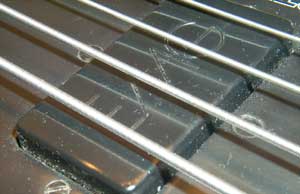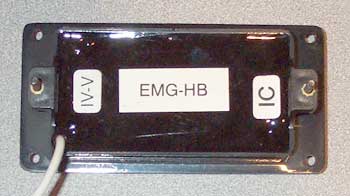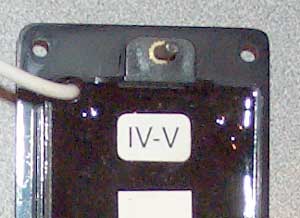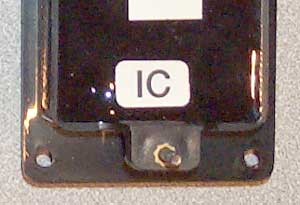
Early molded EMG bass humbucker
EMG & THE 'HB'
Uncommon pickups for an uncommon instrument
When Ned was designing his L series bass in 1979, it was obvious that standard off-the-shelf pickups would not faithfully reproduce the sound of his bass. So he enlisted the help of Rob Turner and EMG.
The first pickups they designed were actual humbuckers with a dual coil design and were 1 1/8" x 2 5/8" (the old Gibson mini humbucking size). The pickup housing had raised lettering though some were sanded off. Only the first 24 instruments utilized these odd sized first pickups.

Early molded EMG bass
humbucker
They were troubled by the lack of midrange response from the bass. EMG suggested a P pickup, which is traditionally used in these instances as it has a deeper set coil which in turn produces more midrange. The standard P employs a split pickup which is staggered, but this design would not work for the Steinberger bass.

A Fender Precision (P) bass with it's
namesake staggered P pickup
The graphite and composite structural "beam" of the L bass ran through the length of the body from the neck all the way to the bridge, and drilling into this beam to attach the pickups was not an option. EMG suggested putting the split P design into a guitar humbucking housing. Ned agreed and the EMG-SS (for Steinberger Sound) was born.
SS shots (top & bottom) needed
The SS's were featured in the L's and some early XL basses. They can be recognized by a brass bottom plate with an 'SS' sticker. This plate is drilled with two holes to provide the 'dog ears' for attachment to the faceplate. In addition to the magnets, coils and preamps, they also inserted a steel plate on end (the magnet and plate are in an upside down 'T' formation). This increased induction to the coils which added more to the mids. It's also interesting to note these pickups were set up out of phase which added a bit more midrange as well.
As you could imagine it was very tricky getting all of these components in that little guitar humbucking housing. EMG made the case a bit deeper, but Ned complained it made installation tougher, as there was very little clearance between the bottom of the pickup and the top of that structural beam.
So when Ned was redesigning the bass (what would become the 'XL' model), EMG revisited the design of the pickups. They took a more traditional P pickup design (removing the steel bar and returning to normal phase), put them in their standard guitar humbucking housing, and sent them off to Steinberger for testing. Ned seemed happy with these and the new pickups became known as the EMG-HB. The sticker on the back designates them as such.

Rear view of an EMG-HB (attached to pickup
ring)
Note - Pickup pairs MUST be in phase! The later HB was designed with "normal" phase. EMG no longer makes any stock bass humbucking pickups out of phase. If you need to replace a broken or damaged SS with an HB, you'll need to have a phase inverter wired to one of the pickups. It's a much simpler solution and probably cheaper than ordering a custom out-of-phase pickup. Most people usually replace both pickups at the same time, so few have ever encountered this problem in the field.
You will often find HB's with different color epoxy resin's on the back - namely black or light tan. Black is most common. The tan color epoxy was an experiment with a "faster setting" material but was discontinued after a short time. There are no differences in sound or durability between the two epoxies.
Another difference is the attachment system. In lieu of the the brass plate, the later HB housings have the more traditional molded EMG plastic "ears". These are part of the actual housing and have a threaded bushing for the height adjustment screws molded into it.
The narrow 5 string dilemma
When Ned was introducing his 5 string version of the L2 they realized the pickups they had been using wouldn't work. The early 5's (L2/5 & XL25) were basically a 5 string bridge and headpiece mounted on a standard 4 string width neck (Click here for more info on the narrow 5 bridge).
The story we've gotten from Rob Turner (founder & president of EMG) is that the original SS magnetic structure left too big of a dead zone under the middle A string on the original L2/5. So the magnet & coil design was tweaked for better coverage in the middle. This redesigned model became the IV-V (Roman numerals 4-5) and replaced the production bass humbucker pickups. After that point Steinberger assembled all their basses with the I-IV as a "universal" pickup, regardless of what bridge was being installed. Much easier for manufacturing and production - make one type of pickup, ship one type of pickup, and install one type of pickup. It also lets you swap bridges in existing basses with no hassles.
The factory installed HB pickups that can accommodate the narrow 5 spacing have a "IV-V" sticker on the back of them. Remember that these bass humbuckers are not a true humbucker, but a P style split coil put into a guitar humbucking housing. On a narrow 5 with the original HB, the middle string (usually A) sits on the end of the magnets and sounds "dead". One magnet on the IV-V is extended a little in the middle so the string is covered.

Close-up of the IV-V sticker from the HB
pictured above
From mid 80's through the early 90's the IV-V's are common on all Steinberger basses. Once Gibson stopped offering the narrow 5 option they just put in straight HB's. If you are replacing HB's on a narrow 5, be sure to custom order a Steinberger style IV-V HB from EMG. They do offer this but only as a custom order (this is not mentioned anywhere on their website anywhere).
That other sticker. . .
One other sticker you'll notice on the backs of the EMG bass pickups has two or three letters. These are the "date of manufacture" code and represent the month (if 2 letters) or month and year (if 3 letters) the pickup was made. Each letter represents a number (A, B, C, D, E = 1, 2, 3, 4, 5, etc.). So an HGL sticker would represent the numbers 8, 7 and 12 = December 1987.

Date sticker from above. This one
was made in '93 (I=9, C=3)
The newest version - the EMG-HBCS
In 2002 EMG revisited the design of the EMG-HB pickup for the first time in over 19 years. EMG has been selling a CS (ceramic & steel) version of their Extended Bass series pickups for some time and it's been very popular. You'll recall this is the same general design of the venerable EMG-SS, which purists rave about for their warm tone. EMG is now offering this new pickup, called the EMG-HBCS.
The tone on these is markedly different than the standard HB. Boosted mids with some cutting of the highs make for a very "warm" sound even from an all graphite L. We highly recommend these pickups if you are looking to tame the sterile tone of an XL bass, or need to replace damaged SS or the later HB pickups.
Though technically a custom order item, they are priced the same as the regular HB. Most EMG retailers will be unfamiliar on how to order them, so we recommend you contact well-known Steinberger repair shop Peekamoose to order them. Click here for directions on ordering.
EMG wide 5 string bass pickups
When Steinberger eventually offered a true 5 string bass (commonly referred to as a wide 5), they borrowed the same design idea - use a P bass in a humbucking type housing. The EMG-35P again is a P style split coil in a wide soap bar housing.

Bottom & top view of the wide 5
EMG-35P soapbar pickups.
Only the XQ25 (originally called the Q5) and XL5W (wide 5) basses have true 5 string spacing and sport these wider EMG pickups.
EMG guitar pickups
During it's entire production run Steinberger used stock EMG pickups in many configurations. The mids were a problem on the bass but were weren't an issue in the guitar inherent higher frequency ranges. They installed mostly 85's, 89's and SA's.
A few factory guitars have a EMG-60 humbuckers, which features more mids and high's and sound more like a fat single coil.
Click here to link to the EMG website. Also be sure to check out their FAQ, as they have several answers to specific Steinberger questions.